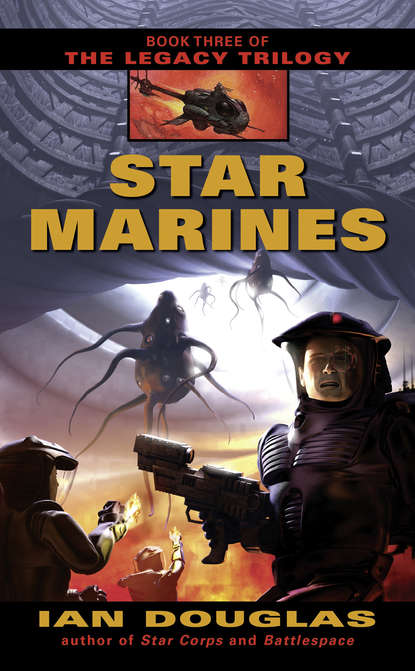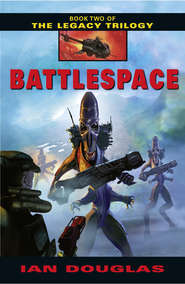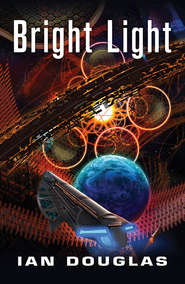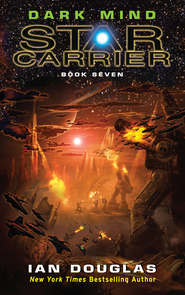По всем вопросам обращайтесь на: info@litportal.ru
(©) 2003-2025.
✖
Star Marines
Настройки чтения
Размер шрифта
Высота строк
Поля
The challenger was patterned, its energies recorded, its material structure dispersed. The patterns of the primitive vessel’s occupants—confirmed as Species 2824—were dissected and questioned, all the way down to the quantum level, confirming the stored data on this system’s species acquired recently from other sources.
The Huntership continued on its implacable course inbound.
Assault Detachment Alpha
Above Olympus Mons,
Mars
1236 hrs, local
Atmospheric drag had slowed his velocity to less than a kilometer per second, and the plasma fireball was dissipating. His noumenal display began showing pinpoints of light against the sky and horizon around him—the other IMAC pods in their descent formation, imbedded in a cloud of decoys.
“Okay, boys and girls,” a voice said over his headset. The ID tag identified it as Lieutenant Wilkie, riding Alpha Flight Six and in charge of the drop. “Sound off!”
“Alpha One, copy and acknowledged,” another voice replied.
“Alpha Two, sweet and neat.” That was Chrome.
“Alpha Three, okay,” Garroway replied.
The litany continued down the roster, until all thirty-two pods had checked in. Garroway breathed a bit easier, then. These pods had been endlessly tested for their re-entry capabilities, both in sim and in actual, but there’d still been that lingering, tiny doubt that something, some design flaw, might have been overlooked. But they all had made it past the first hurdle, at least.
“Hey, Chrome,” he called on a private lasercom channel. “Did you get a load of Olympus coming down? Looked like the Solar System’s biggest tit.”
“Roger that, Trigger. But her nipple was an innie, not an outie.”
“Collapsible model, Chrome.”
“Can the chatter, people,” Wilkie said, cutting in. “Verify ECM, and release chaff.”
An alarm sounded in his mind. His pod was being tracked by ground radar. Decoys or not, the pretend enemy on the ground was watching their approach, and had just targeted him.
Not good. Garroway—“Trigger” to the other Marines in Alpha Company—engaged Level One ECM. A thought fired six chaff canisters from the outside hull. The cloud of silvered Mylar expanded around him, mingling with ablative fragments still following the pod’s descent. They might see them coming from the ground, but it would be next to impossible to know what to shoot at.
That was the idea, at least. Part of the Marines’ training involved spending time in a ground fire-control radar center, watching this sort of exercise from the other side. At times like this, it could be comforting to know that the ground techs were seeing an ungodly hash of static on their screens, not the array of sixteen crisp, sharp blips that meant a flight of incoming hostiles.
Minutes more passed. They were twelve kilometers up, and one hundred from the LZ. “Alpha Flight, Alpha Six. Deploy aeroform flight surfaces for landing.”
At a focused thought, portions of Garroway’s pod began unfolding, transforming the cylindrical pod into a blunt-nosed lifting body. The tiny craft shuddered and banged, engaging atmosphere as his rate of descent decreased. His battlesuit AI noted that the flight surfaces had deployed; there would be no need for emergency HALO systems.
Noumenal indicators showed the Oannan drive coming up to power. That was the really scary part of this exercise … working with that alien and poorly understood technology. The amphibian Oannans, or the N’mah, as they called themselves, discovered at the Sirius Stargate a century and a half ago had been working with human scientists ever since, helping them integrate bits and pieces of archeotechnology into a coherent understanding of advanced physics. Humankind had a long way to go on that road, but one bit of early payoff, if the science techs were to be believed, was that long-dreamed-of, long-unachievable Holy Grail of propulsion technology, a reactionless drive.
The Marines’ lives were quite literally riding on the gadget. If the Foureyes’ little wonder child didn’t work as advertised, there shortly would be sixteen fresh, bright, new craters in the Martian desert, and Bravo 2/1 would need to send for newbie replacements from Lejeune, stat.
“Okay, people,” Wilkie’s voice said. Was that nervousness adding a ragged edge to his voice, or just an effect of vibration as his pod slammed into heavier atmosphere? “Nice and easy, just like in the sims. Deploy inertial dampers and engage QRD.”
Inertial dampers switched on, softening the pods’ headlong plummet. They did not completely erase inertia—even the Oannans couldn’t stop their spacecraft on the proverbial dime without deceleration—but they did muffle the occupants from the effects of abrupt, high-speed maneuvering.
Of course, the thirty-two incoming pods no longer responded like dead lumps of metal dropping through atmosphere. Drag now had a much greater effect, slowing their velocity substantially.
And that meant their obscuring cloud of chaff and ablative debris now left them, racing ahead at near-terminal velocity while the pods abruptly slowed. Red light warnings flared in Garroway’s mind. The strike force was now being clearly illuminated by ground-based radar and ladar.
“Alpha Flight, evasive pattern one!” Wilkie shouted over the laser link. “Down on the deck!”
In tight, echelon formation, the flight engaged their Quantum Reactionless Drive units, veering sharply into a near-vertical drop, plunging toward the desert. At fifteen hundred meters they pulled up sharp and hard, arrowing across the blurring ocher surface of the desert. For ninety seconds more, they held to their course, before decelerating hard and descending the final mile to the surface of the desert.
The shock wave of their passage stirred swirling clouds of dust in their wakes. With the Oannan drives on full, they slowed, then slammed into the ground, the shock—most of it, anyway—absorbed by the inertial dampers.
The black hull of Alpha Three split open, folding back on itself, and Garroway emerged, unfolding from an uncomfortable crouch. His armor, coated with chameleonic surfacing, showed the jet black of the pod’s interior, but in seconds had faded to an overall ocher-red, mirroring almost perfectly the surrounding color and shapes of desert and a pink-tinted sky. The Mark XLIV Marine CAS, or Combat Armored Suit, stood just over two meters tall, massive and blocky, a walking tank. A Hawking 34mm chaingun firing high-explosive rounds was mounted on the machine’s right forearm; an A-frame launch unit strapped to the massive back carried three Shrike-C missiles with AI guidance and tactical nuclear warheads, each packing a two-kiloton punch. The suit’s on-board AI unit was smarter than a man, with better speed, better memory, and better focus, though it lacked emotion or a sense of morals, of right and wrong. Kill-no-kill decisions still required a human wired into the decision circuit.
The Mk. XLIV—the “Fighting Forty-four”—was widely viewed in military circles as the endpoint of the evolution of individual combat armor, massive, high-powered, and lethal. Current military doctrine declared that the life expectancy of an unarmored man on the modern battlefield was to be measured in scant seconds, and the Mk. XLIV was intended to extend that lifespan to minutes, even to hours.
At the moment, there were thirty-two Marines in Mk. XLIVs scattered across the desert in a footprint twelve kilometers across. According to satellite nav data, they’d come down precisely on the planned LZ which, if all had worked as planned, put them well inside the opposing force’s perimeter, almost on top of their objective.
“Okay, Marines!” Wilkie called. “Let’s move!”
“Ooh-rah!” Garroway and the other Marines chorused, the ancient war-cry of the Corps.
The formation turned east and began moving, loping across the broken and water-eroded desert floor at a ground-eating five kilometers per hour.
We Who Are
Outer Solar System
0448 hrs, GMT
The Huntership continued its approach to the target world, sensors fully deployed, tasting the radiations and reflections of an immense volume of local space. A second artificial structure was detected, a large one—almost a quarter of the Huntership’s mass—moving in an extended orbit well above the system ecliptic.
Again, We Who Are extended their collective consciousness, almost casually reaching for this new target. …
2
12 FEBRUARY 2314
High Guard Monitor U.E.S. Prometheus
Trans-Saturn Space
1248 hrs, local
In the dark and lonely gulf beyond the orbit of Saturn, one light-hour from a dim and shrunken Sol, the U.E.S. Prometheus maintained her year-long vigil.
During the twenty-first century, during the UN War, an attempt had been made to shift the orbit of a bit of nickel-iron debris in order to bring it down on North America with the destructive impact of many fusion warheads—a single blow to end a savage and expensive war. The attempt had failed—mostly. The wreckage of the spacecraft engaged in the tricky maneuver had come down over Lake Michigan; the ruins of Old Chicago would remain radioactively uninhabitable for a number of centuries yet to come.
Later, as Humankind began exploring its interstellar neighborhood, unsettling discoveries came to light, discoveries to the effect that the galactic predators known as the Hunters of the Dawn used asteroids to destroy promising civilizations, including the Ancients. Exoarcheologists were still exploring the planetwide ruins on Chiron, in the Alpha Centauri system, and believed that the Ancients’ colony on Mars had failed when an asteroid impact there had stripped away much of the artificially induced atmosphere. The An colony on Earth eight millennia ago—and the nascent human civilization that served as their slaves—had been wiped out by a small asteroid dropped into what was now the Arabian Gulf.
Evidently, when it came to planet-wrecking, asteroids were the long-established weapon of choice.











